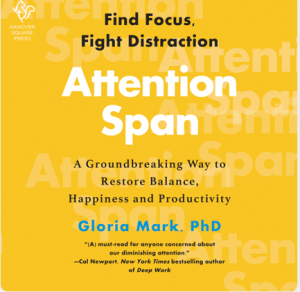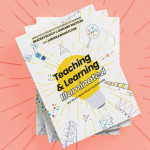 In our world we now spend over 10 hours a day in front of screens; our mind wanders, we get distracted, and before we know it, we have accomplished next to nothing. So, we subscribe to podcasts, read self-help books (not unlike this one), and search for the hacks that can keep us in a strong state of optimal “focus” or “flow.” We feel that regular focus at work is the goal; we give ourselves very little wiggle room; and we often make digital media the enemy. We need to learn to focus better. Gloria Mark reframes all of this in Attention Span, an intriguing exploration of our attention spans in the digital era.
In our world we now spend over 10 hours a day in front of screens; our mind wanders, we get distracted, and before we know it, we have accomplished next to nothing. So, we subscribe to podcasts, read self-help books (not unlike this one), and search for the hacks that can keep us in a strong state of optimal “focus” or “flow.” We feel that regular focus at work is the goal; we give ourselves very little wiggle room; and we often make digital media the enemy. We need to learn to focus better. Gloria Mark reframes all of this in Attention Span, an intriguing exploration of our attention spans in the digital era.
Mark provides a balanced view on focus and distraction. She challenges common myths throughout. Contrary to popular belief, constantly striving for intense focus while using computers doesn’t always equate to productivity; it’s healthy to have less concentrated moments too. The ideal state of ‘flow’ with technology is beneficial, but it’s not a mandatory goal for every task. Distractions and multitasking aren’t just a result of notifications or lack of discipline; they often arise from various factors beyond our control. Also, we should not underestimate the value of what seems like mindless activities on our devices; these can actually provide necessary mental breaks that boost our overall productivity and add to happiness at work. Understanding these aspects can lead to a more balanced and effective approach to our digital lives.
The book is dominated by her refreshing and unique approach to research and thinking that drive the structure of the book from life to interviews to lab. She starts from a common ground, exploring well-known concepts like ‘flow’ – the deep immersion in an activity, and then evaluates whether this strived-for experience is found in real practice and if it’s all it’s cracked up to be. Is it really the optimal experience? Mark acknowledges that while the concept of flow is intriguing, its occurrence in the workplace is not as frequent as one might think. As with other concepts in the book, rather than discarding this idea, she takes it further, testing and applying it in real-world settings. She adapts similar research methods, poses fresh questions, and rethinks approaches based on her observations. This dynamic between scientific rigor her curiosity and real-world applications creates an engaging narrative that captivates the reader throughout the book.
A core idea in the book is the idea of kinetic attention. The ability to shift strategically between attention types of rote activity, frustrated, focused, and bored is an important attentional skill. And she suggests ways to master it. But one of the first steps is really understanding attention as a dynamic activity that changes across the day, across the week, and other cycles of life. However, keeping this in mind she writes with subtle evaluation of free will throughout the book with a direct intriguing discussion at the end. What does it mean to control attention? Why do some people feel they control their minds and environment while others feel like they are at the whim of notifications and distractions?
There are many fresh and interesting ideas that make you widen your eyes. She teases us with “You may not have thought that playing Candy Crush can actually help us achieve a psychological balance in our workday, but that might soon change” (p. 210). What?! I wanted to read more. And her hope of integrating technology and not demonizing it is really a nice touch of reality. Another intriguing finding from Gloria Mark’s research might make you rethink your beliefs about Facebook: people who spent more time on Facebook tended to report higher levels of happiness at the end of the day. In contrast, the amount of time spent in face-to-face interactions throughout the day didn’t demonstrate a significant correlation with changes in their mood by day’s end.
The final part of the book is packed with practical advice, from setting goals to managing interruptions and incorporating mindfulness practices. These tips are invaluable for anyone looking to improve their attention span in a world rife with digital distractions.
Gloria Mark doesn’t just discuss problems; she provides a roadmap for thriving amidst digital distractions and opportunities, making it a must-read for educators, students, professionals, or anyone seeking to optimize their attention in this screen-filled age. Screens are not going away, and neither are other distractions. Distractions need to be understood not simply avoided.



